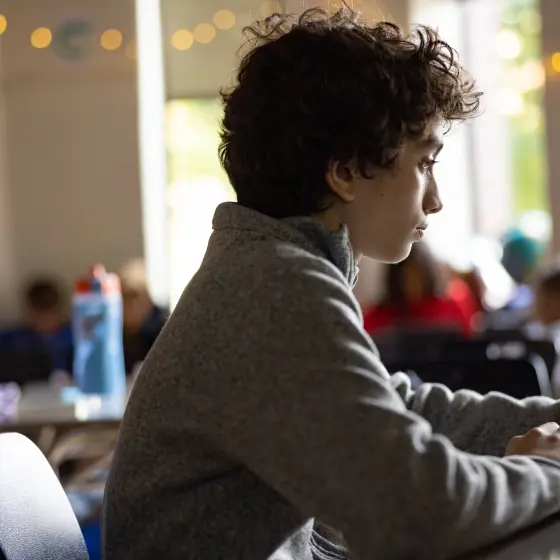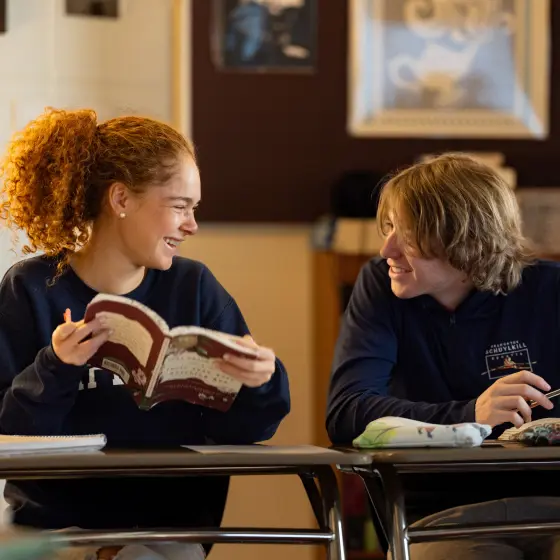An Outdoor Space for All Ages
The entire plot has the potential to be transformed into a multi-functional & interactive.
|
“The backlot and playground are communal spaces that have so much more potential to sustain and enhance our sense of community,” explained Michael Gary, head of school, who underscored how this project will address the “use of space” and “excellence in teaching and learning” pillars of our strategic plan. “The area will become a gathering outdoor space for all ages. Now that’s transformational! |
The next phase of the Advance Friends Select: Transformation Campaign is focusing on a redesign of the Parkway backlot, playground, and parking area.
The entire plot has the potential to be transformed into a multi-functional, interactive, outdoor play space that will be accessible to all Friends Select students, from pre-kindergarten to 12th grade. “The backlot and playground are communal spaces that have so much more potential to sustain and enhance our sense of community,” explained Michael Gary, head of school, who underscored how this project will address the “use of space” and “excellence in teaching and learning” pillars of our strategic plan. “The area will become a gathering outdoor space for all ages. Now that’s transformational!
The Redesign
The redesign project is being led by Anchor Management Group, which oversaw previous Transformation Campaign updates to the Parkway Building’s first floor and rooftop athletic field, as well as the creation of the upper school STEAM Building. Additional landscape and play architects round out the design team, including local firms Metcalfe Architecture & Design, Studio Ludo, and OLIN. “Our work together is in nature play, but also immersive play environments that have architectural components, and is really focused on providing great opportunities for kids to develop through play throughout life,” said Meghan Talarowski, founder and executive director
of Studio Ludo. “We think about the relationships, the play patterns, the whole environment, and how that environment can invite everybody in.
Engagement
In the first stage of the project, the design team met with Friends Select faculty and staff from each division to identify overarching goals. With the safety of our community a top priority, other objectives included engaging more upper and middle school students in a space that has been used primarily by lower school students. There was also an interest in creating a backlot beacon to draw prospective students and families to Friends Select.
In addition, faculty and staff wanted to examine the potential
for vertical elements that could maximize play space while increasing accessibility and circulation between the Parkway Building and the outdoor area.
Lower School
Students’ perspectives were also essential in the early design stages. The design team invited all three divisions to brainstorming sessions to better understand student desires for the playspace. To engage the youngest learners, lower school students were asked to create their own three-dimensional models in a hands-on exercise. “Model building gives younger students language through material and art, so they can describe to us how they want to feel and be in the space, with the ultimate goal of defining the play culture of the school and identifying how we can create the environment that fosters the play culture they’re looking for,” Meghan said.
Middle School
In the middle school engagement session, a student focus group defined “play” in a variety of ways, from physical activity to being creative to socializing with friends. “Middle school students are transitioning into grownups and so their realm of possibilities is narrowing. It’s not that they stop playing; it’s just that their play is transitioning into social engagement,” Megan explained. With the design team, students visualized an outdoor play area that maximizes vertical space, provides areas for socialization or quiet time, has the ability to be used for learning, and features a slide from the rooftop athletic field. Additionally, many middle school students expressed appreciation for an outdoor space that fosters active, physical play. “Whenever I run around outside, I’m able to focus more when I get back into the classroom setting because I’m able to let off the natural energy I’ve been building up throughout the school day,” said Quinn Greenwood ’28 in the engagement session.
Middle school art teacher Fred Kogan served on the faculty and staff focus group for the redesign project, and highlighted the importance of including input from students in his division. “I truly believe that having middle school students as designers is so helpful for the adult design team. Students in these grades really understand the best ways to play and interact with each other, and they also know when they need quiet moments to be with themselves too,” said Fred. “Middle schoolers love the outdoors and find it a great place to learn, as well as play, in a hands-on way. They are great at thinking out of the box and designing without a budget. My hope is that their ideas have a major impact on the final design.”
Friends Select senior and student government co-president May Colgan ’23 presented to the design team data she collected through polling her peers about the project. A primary request of her age group was seating that combines both play and function. Free time during a typical day for upper school students is used for lunch, studying, or club meetings; therefore, an outdoor space that facilitates all of those activities and accommodates groups would be ideal. In their feedback, students suggested swings, slides, and a multi-level playscape.
Upper School
Upper school students were excited about being asked to participate in the redesign of a space that, for many, was central to their play as lower school students. “The backlot space has been off limits for upper schoolers for a long time, and it’s cool to see the nostalgia and significance that space holds for many long-time students. We were really excited to weigh in on the project and see some of the past work of the design team,” May said. “Once we got students to think beyond the traditional setup that exists currently, we got many enthusiastic and creative responses. You can see that even upper school students haven’t outgrown the joy of play.”
The design team is currently processing the ideas and information they collected from the community, and categorizing the feedback to navigate the types of experiences students are looking for in their playspace. Some examples are sensory-based, build experiences, structured games, physical activity, and both social and solitary connection. Students from all three divisions expressed enthusiasm for the inclusion of a vertical structure, along with utilizing the existing tree as part of the redesign. “We received a lot of feedback from students regarding nature,” Meghan explained. “I think that speaks to Friends Select’s intention in letting students go outside so often.”
Ultimately, pulling together the viewpoints of all community members is a crucial first step in the design process. “Having discussion and engagements with a wide range of user groups, from little ones to adults, allows us to understand how the space might be used,” said Christopher Kircher, partner and studio director of Metcalfe Architecture & Design. “The point is that we are listening to see how we can incorporate and make the community feel part of that location, that build, that play, and that culture.”
“We want our students to experience design thinking and feel a part of the design process; we want a product they will enjoy and have a sense of ownership,” added Michael. “It is important to me that our community sees and feels that the outdoor space was built with them specifically in mind.” Friends Select’s redesigned backlot and playground are scheduled to be completed prior to the start of the 2024-25 school year.
For more information about this project, or to support the Advance Friends Select: Transformation Campaign, Email or Call Christine Jefferson, chief development officer.
Where Next?





